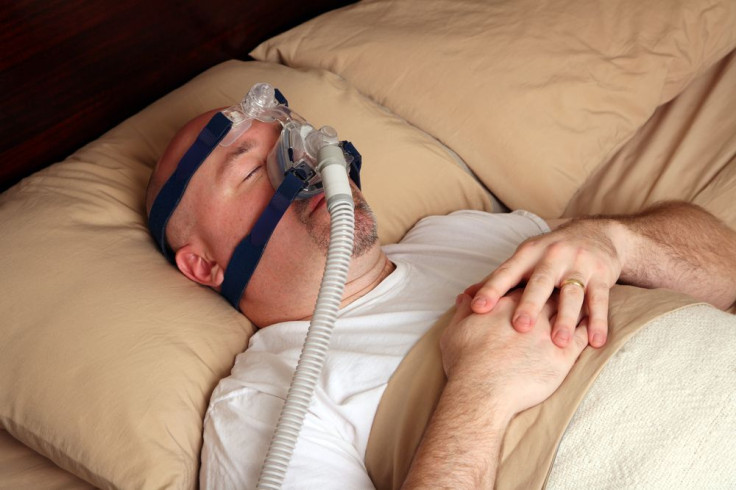Sleep Apnea Raises Diabetes Risk By 30 Percent; Heart And Breathing Are To Blame

Sleep affects our overall health tremendously, and researchers are discovering just how many diseases and conditions the body becomes susceptible to when it isn’t given its allotted eight hours a night. Researchers from the University of Toronto studied the connection between obstructive sleep apnea (OSA) and diabetes using 8,678 Canadian patients., making it the largest study to test the relationship yet.
"Our study, with a larger sample size and a median follow-up of 67 months was able to address some of the limitations of earlier studies on the connection between OSA and diabetes," said lead author Dr. Tetyana Kendzerska, of the University of Toronto, in a press release. "We found that among patients with OSA, the initial severity of the disease predicted the subsequent risk for incident diabetes."
The study, which was published in the American Thoracic Society's American Journal of Respiratory and Critical Care Medicine, found that patients who had even a mild or moderate case of OSA increased their risk of developing diabetes by 23 percent. Those with severe OSA had a 30 percent higher risk of developing diabetes than those without OSA. The link between diabetes and OSA has been known, however, only small studies have tested and proven the relationship.
Obstructive sleep apnea (OSA) was discovered by a group of American pulmonologists in 1956 who identified patients who were both extremely obese and experiencing extreme daytime sleepiness. This came at a time when only about 33 percent of U.S. adults were overweight and 10 percent were obese, according to the Department of Agriculture — a comparatively low population when placed next to today’s staggering 35.7 percent obesity rate.
OSA, one of the most infamous of sleep issues, occurs in 50 percent of obese individuals, according to the American Academy of Sleep Medicine. Apnea which is a 90 percent reduction of airflow, may occur in periods as often as 50 to 100 times per hour, which creates a cycle of constant re-awakening throughout the night.
Just the idea that someone is choking hundreds of times a night sounds like a form of torture. But the sleeper remains none the wiser to their dangerous nightly suffering, which is why many times a patient undergoes a sleep study because their spouse is worried or annoyed by the snoring suffocation. Although, those with sleep apnea aren’t completely oblivious to their body’s suffering considering they’re losing at least a third of quality sleep, they eventually feel the effects during the day. While awake, they may become acutely aware of their daytime tiredness, chronic fatigues and lack of physical energy, or endurance to complete a task.
"After adjusting for other potential causes, we were able to demonstrate a significant association between OSA severity and the risk of developing diabetes," Kendzerska said. "Our findings that prolonged oxygen desaturation, shorter sleep time, and higher heart rate were associated with diabetes are consistent with the pathophysiological mechanisms thought to underlie the relationship between OSA and diabetes."
Doctors calculate an individual’s apnea hypopnea index (AHI) in order to assess treatment plans according to severity. The total number of apnea events plus the total number of hypopnea events are added together and then divided by the number of minutes slept during the night, which is finally multiplied by 60. An apnea is a complete pause in breathing during a person’s sleep, while a hypopnea is a 30 percent reduction in airflow that lasts at least 10 seconds.
When a person suffering from OSA is sleeping, their muscles relax, and the soft tissue in the back of their throats subsequently collapses and blocks their airway for a minimum of 10 seconds. It may not seem like a significant enough amount of time to cause long-term bodily harm, such as increased risk of high blood pressure, cardiac problems, increased insulin resistance, and stroke, but it is.
"The OSA-related predictors of increased diabetes risk that we found in our study may allow for early preventative interventions in these patients," Kendzerska said.
The frequency in which this happens every night varies tremendously from patient to patient. The American Academy of Sleep Medicine constructed the AHI adult scale in order to provide a range for doctors to diagnose and insurance companies to determine coverage based on the measurement of choking episodes. A mild sleep apnea sufferer will experience five to 15 apneas or hypopneas per hour, while 15 to 30 categorize a moderate sleep apnea victim, and more than 30 per hour are considered severe and require immediate corrective treatment.
Sleep apnea directly causes chronic sleep deprivation and results in daytime sleepiness, slower reflexes, poor concentration, and increased risk of car accidents. Long-term problems pose more severe health consequences, including diabetes, high blood pressure, heart disease, stroke and weight gain. Between 50 and 70 million Americans are affected by chronic sleep disorders, according to the National Sleep Foundation, an independent nonprofit organization established in 1990 to collect and educate sleep research for the general public.
Following closely behind was the 1993 opening of the National Center on Sleep Disorders Research, a branch within the National Institutes of Health (NIH). The center was established to fill the demand for research funding for a growing population of Americans living with sleep problems and disorders, according to the Harvard School of Sleep Medicine.
Source: Kendzerska T, Gershon AS, Hawker G, et al. Obstructive Sleep Apnea and Incident Diabetes: A Historical Cohort Study. American Journal of Respiratory and Critical Care Medicine. 2014.



























